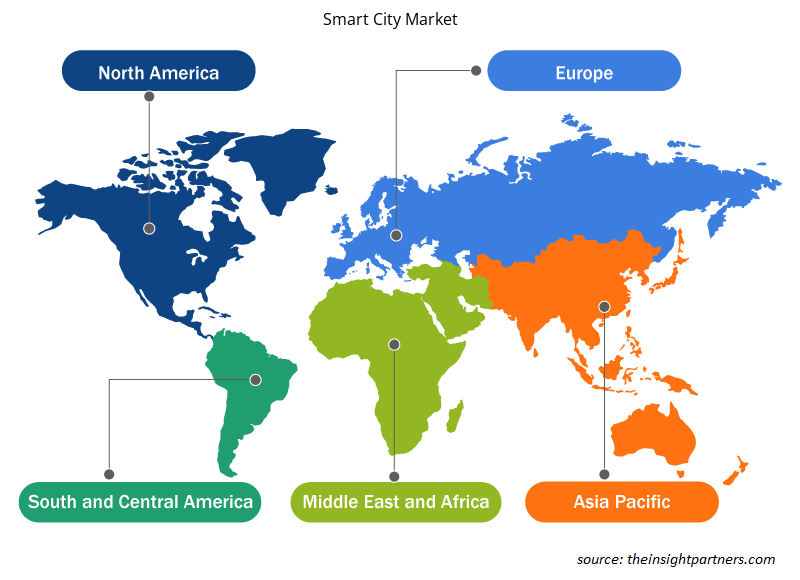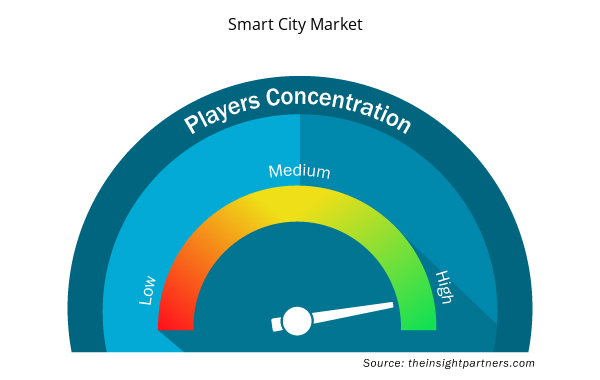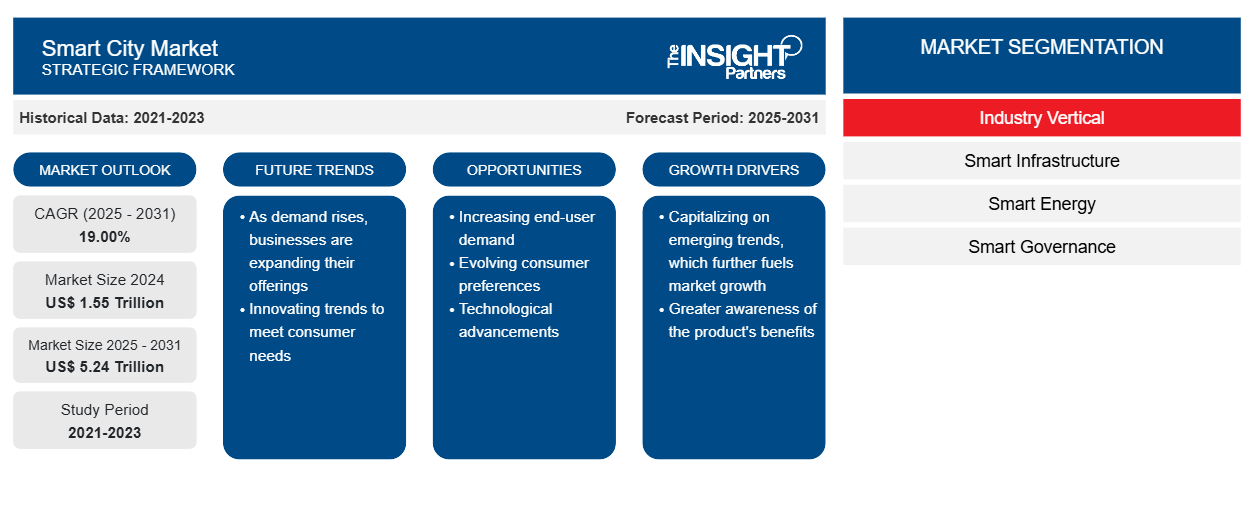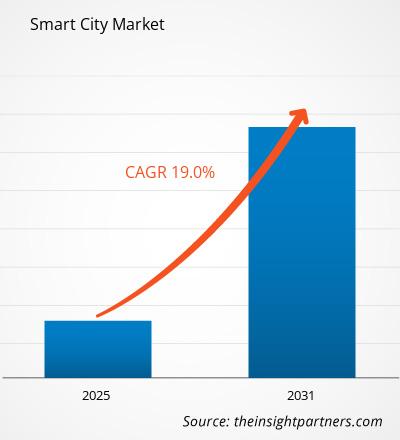スマートシティ市場は、2022年の1,0942.3億米ドルから2031年には3,1105.8億米ドルに成長すると予想されており、2022年から2031年にかけて年平均成長率19.0%で成長すると予測されています。
スマート シティとは、都市や地方のさまざまな側面が高度なテクノロジーに基づいているという概念です。これらの都市は、デジタル テクノロジーとインターネットを使用して、エネルギーを最適化し、住民のセキュリティを向上させることで、サービスのパフォーマンスと生活の質を高めます。スマート シティの概念は、住民、サービス プロバイダー、管理者を効率的に接続できる管理システムを構築するために、リアルタイムの情報アクセスを可能にする堅牢な接続性とインフラストラクチャを開発することを目指しています。さらに、政府は、都市に基本的なインフラストラクチャを提供することで、住民がサービスの全体的な持続可能性と生産性の向上に積極的に参加できるようにします。
スマート インフラストラクチャ テクノロジーは時間の経過とともに大きく変化し、施設および緊急対応管理のためのビル自動化、ビルのエネルギー最適化、駐車場管理、ビル内通信システムなど、さまざまな分野が現在広く採用されています。さらに、グリーン ビルディングの取り組みは、特にヨーロッパ、北米、アジア太平洋地域の多くの国で中心的な位置を占めています。エネルギー消費の削減への重点と環境廃棄物の急増に対する懸念は、スマート シティの開発を推進する主な要因です。スマートシティ市場の予測期間中、交通はもう 1 つの主要な焦点領域になると予想されます。
要件に合わせてレポートをカスタマイズする
このレポートの一部、国レベルの分析、Excelデータパックなど、あらゆるレポートを無料でカスタマイズできます。また、スタートアップや大学向けのお得なオファーや割引もご利用いただけます。
- このレポートの主要な市場動向を入手してください。この無料サンプルには、市場動向から見積もりや予測に至るまでのデータ分析が含まれます。
エネルギー源の枯渇と非効率的なリソース管理は、世界中で徐々に大きな懸念事項になりつつあります。これが、世界中でスマート エネルギー ソリューションの需要を促進しています。スマート エネルギー管理システムは、センサー、高度なメーター、再生可能エネルギー源、デジタル制御、分析ツールを使用して、エネルギーの分配と使用を自動化、監視、最適化します。このようなシステムは、関係するさまざまな利害関係者 (消費者、生産者、プロバイダー) のニーズのバランスをとることで、グリッドの運用と使用を最適化します。スマート エネルギー インフラストラクチャには、分散型再生可能エネルギー発電、マイクログリッド、スマート グリッド技術、エネルギー貯蔵、自動需要応答、仮想発電所、電気自動車やスマート家電などの需要側のイノベーションなど、いくつかのイノベーションがあります。このようなイノベーションにより、都市全体にインテリジェント エネルギー デバイスの拡張ネットワークが提供され、エネルギー消費パターンの詳細なビューが提供され、コミュニティベースのエネルギー監視プログラムが可能になり、建物のエネルギー効率が向上します。
スマートシティ市場の地域分析
地域別に見ると、2021年に世界のスマートシティ市場で最大のシェアを占めたのは北米でした。この地域のすべての産業分野で技術的に高度なソリューションが広く採用されていることが、北米のスマートシティ市場の成長に貢献しています。補助金、税額控除、技術開発のための業界への資金提供の発表を通じて、技術採用に対する政府のサポートが増加していることで、市場がさらに活性化し、地域全体で活動するスマートシティ市場のプレーヤーに有利なビジネスチャンスが提供されています。たとえば、2021年11月、米国連邦政府は、スマートシティの課題を克服するために、インフラ投資・雇用法に基づいて5億ドルの資金提供を発表しました。さらに、地域全体にいくつかのスマートシティ市場のプレーヤーが存在し、絶え間ない革新と製品開発に取り組んでいることで、北米のスマートシティ市場がさらに推進されています。
市場洞察 – スマートシティ市場
業界別の洞察
業界別では、スマートシティの市場規模は、スマートインフラストラクチャ、スマートエネルギー、スマートガバナンス、スマート交通、スマートヘルスケア、スマート教育に分類されます。スマート交通セグメントは、予測期間中に最高のCAGRで成長すると予想されています。スマート交通は、新しいテクノロジーに基づいて構築され、リソースを節約して効率を最大化するように設計された革新的な交通およびモビリティインフラストラクチャです。クラウドコンピューティング、4G、マシンツーマシン学習、新しいプロジェクトでの運用などの主要なテクノロジーの導入は、鉄道などのスマート輸送システムにさらに一般的に適用され、世界中で効率的な乗客および貨物サービスを提供し、スマートシティのエコシステムにおける多数の業界プレーヤーに機会のプールが生成されるようになります。これはまた、さまざまな資本家や投資家を引き付け、スマート輸送市場の驚異的な成長につながるでしょう。
スマートシティ市場の地域別洞察
予測期間を通じてスマート シティ市場に影響を与える地域的な傾向と要因は、Insight Partners のアナリストによって徹底的に説明されています。このセクションでは、北米、ヨーロッパ、アジア太平洋、中東、アフリカ、南米、中米にわたるスマート シティ市場のセグメントと地理についても説明します。

- スマートシティ市場の地域別データを入手
スマートシティ市場レポートの範囲
| レポート属性 | 詳細 |
|---|---|
| 2023年の市場規模 | 1.30兆米ドル |
| 2031年までの市場規模 | 5.24兆米ドル |
| 世界のCAGR(2023年~2031年) | 19.00% |
| 履歴データ | 2021-2022 |
| 予測期間 | 2024-2031 |
| 対象セグメント | 業種別
|
| 対象地域と国 | 北米
|
| 市場リーダーと主要企業プロフィール |
|
市場プレーヤーの密度:ビジネスダイナミクスへの影響を理解する
スマート シティ市場は、消費者の嗜好の変化、技術の進歩、製品の利点に対する認識の高まりなどの要因により、エンド ユーザーの需要が高まり、急速に成長しています。需要が高まるにつれて、企業は提供内容を拡大し、消費者のニーズを満たすために革新を起こし、新たなトレンドを活用し、市場の成長をさらに促進しています。
市場プレーヤー密度とは、特定の市場または業界内で活動している企業または会社の分布を指します。これは、特定の市場スペースに、その市場規模または総市場価値に対してどれだけの競合相手 (市場プレーヤー) が存在するかを示します。
スマートシティ市場で活動している主要企業は次のとおりです。
- ABB株式会社
- アクセンチュア
- シスコ
- エリクソン
- シュナイダーエレクトリック
- GE
免責事項:上記の企業は、特定の順序でランク付けされていません。

- スマートシティ市場のトップキープレーヤーの概要を入手
スマートシティ市場で活動する企業は、主に先進的で効率的な製品の開発に重点を置いています。
- 2021年10月、シーメンスAGはSquillsの買収を発表しました。この買収により、予約や発券ソフトウェアなどの同社のモビリティソリューションが強化されました。
- 2021 年 5 月、Microsoft Corporation と Itron Inc は、高度なモバイル デバイス管理 (MDM) サービスを共同で顧客に提供するための戦略的パートナーシップを締結しました。
スマート シティ市場の規模は、北米、ヨーロッパ、アジア太平洋 (APAC)、中東およびアフリカ、南米の 5 つの主要地域に分割されています。2022 年には、北米が大きな収益シェアで市場をリードし、ヨーロッパがそれに続きました。さらに、アジア太平洋地域は、2022 年から 2031 年にかけてスマート シティ市場で最高の CAGR を記録すると予想されています。
世界のスマート シティ市場の主要プレーヤーには、ABB Ltd、Cisco Systems、Inc.、Oracle Corporation、Microsoft Corporation、IBM Corporation などがあります。これらのほかにも、Accenture、General Electric Company、Schneider Electric SE、Siemens AG、Ericsson AB など、いくつかのプレーヤーが調査研究中に分析されました。
- 過去2年間の分析、基準年、CAGRによる予測(7年間)
- PEST分析とSWOT分析
- 市場規模価値/数量 - 世界、地域、国
- 業界と競争環境
- Excel データセット


- E-Bike Market
- Single-Use Negative Pressure Wound Therapy Devices Market
- Frozen Potato Market
- Medical and Research Grade Collagen Market
- Hand Sanitizer Market
- Artificial Turf Market
- Joint Pain Injection Market
- Extracellular Matrix Market
- Aircraft Landing Gear Market
- Advanced Planning and Scheduling Software Market

Report Coverage
Revenue forecast, Company Analysis, Industry landscape, Growth factors, and Trends

Segment Covered
This text is related
to segments covered.

Regional Scope
North America, Europe, Asia Pacific, Middle East & Africa, South & Central America

Country Scope
This text is related
to country scope.
Trends and growth analysis reports related to Electronics and Semiconductor : READ MORE..
The List of Companies - Smart Cities Market
- ABB Ltd.
- Accenture
- Cisco
- Ericsson
- Schneider Electric
- GE
- Microsoft
- IBM Corporation
- Oracle
- Siemens
The Insight Partners performs research in 4 major stages: Data Collection & Secondary Research, Primary Research, Data Analysis and Data Triangulation & Final Review.
- Data Collection and Secondary Research:
As a market research and consulting firm operating from a decade, we have published and advised several client across the globe. First step for any study will start with an assessment of currently available data and insights from existing reports. Further, historical and current market information is collected from Investor Presentations, Annual Reports, SEC Filings, etc., and other information related to company’s performance and market positioning are gathered from Paid Databases (Factiva, Hoovers, and Reuters) and various other publications available in public domain.
Several associations trade associates, technical forums, institutes, societies and organization are accessed to gain technical as well as market related insights through their publications such as research papers, blogs and press releases related to the studies are referred to get cues about the market. Further, white papers, journals, magazines, and other news articles published in last 3 years are scrutinized and analyzed to understand the current market trends.
- Primary Research:
The primarily interview analysis comprise of data obtained from industry participants interview and answers to survey questions gathered by in-house primary team.
For primary research, interviews are conducted with industry experts/CEOs/Marketing Managers/VPs/Subject Matter Experts from both demand and supply side to get a 360-degree view of the market. The primary team conducts several interviews based on the complexity of the markets to understand the various market trends and dynamics which makes research more credible and precise.
A typical research interview fulfils the following functions:
- Provides first-hand information on the market size, market trends, growth trends, competitive landscape, and outlook
- Validates and strengthens in-house secondary research findings
- Develops the analysis team’s expertise and market understanding
Primary research involves email interactions and telephone interviews for each market, category, segment, and sub-segment across geographies. The participants who typically take part in such a process include, but are not limited to:
- Industry participants: VPs, business development managers, market intelligence managers and national sales managers
- Outside experts: Valuation experts, research analysts and key opinion leaders specializing in the electronics and semiconductor industry.
Below is the breakup of our primary respondents by company, designation, and region:

Once we receive the confirmation from primary research sources or primary respondents, we finalize the base year market estimation and forecast the data as per the macroeconomic and microeconomic factors assessed during data collection.
- Data Analysis:
Once data is validated through both secondary as well as primary respondents, we finalize the market estimations by hypothesis formulation and factor analysis at regional and country level.
- Macro-Economic Factor Analysis:
We analyse macroeconomic indicators such the gross domestic product (GDP), increase in the demand for goods and services across industries, technological advancement, regional economic growth, governmental policies, the influence of COVID-19, PEST analysis, and other aspects. This analysis aids in setting benchmarks for various nations/regions and approximating market splits. Additionally, the general trend of the aforementioned components aid in determining the market's development possibilities.
- Country Level Data:
Various factors that are especially aligned to the country are taken into account to determine the market size for a certain area and country, including the presence of vendors, such as headquarters and offices, the country's GDP, demand patterns, and industry growth. To comprehend the market dynamics for the nation, a number of growth variables, inhibitors, application areas, and current market trends are researched. The aforementioned elements aid in determining the country's overall market's growth potential.
- Company Profile:
The “Table of Contents” is formulated by listing and analyzing more than 25 - 30 companies operating in the market ecosystem across geographies. However, we profile only 10 companies as a standard practice in our syndicate reports. These 10 companies comprise leading, emerging, and regional players. Nonetheless, our analysis is not restricted to the 10 listed companies, we also analyze other companies present in the market to develop a holistic view and understand the prevailing trends. The “Company Profiles” section in the report covers key facts, business description, products & services, financial information, SWOT analysis, and key developments. The financial information presented is extracted from the annual reports and official documents of the publicly listed companies. Upon collecting the information for the sections of respective companies, we verify them via various primary sources and then compile the data in respective company profiles. The company level information helps us in deriving the base number as well as in forecasting the market size.
- Developing Base Number:
Aggregation of sales statistics (2020-2022) and macro-economic factor, and other secondary and primary research insights are utilized to arrive at base number and related market shares for 2022. The data gaps are identified in this step and relevant market data is analyzed, collected from paid primary interviews or databases. On finalizing the base year market size, forecasts are developed on the basis of macro-economic, industry and market growth factors and company level analysis.
- Data Triangulation and Final Review:
The market findings and base year market size calculations are validated from supply as well as demand side. Demand side validations are based on macro-economic factor analysis and benchmarks for respective regions and countries. In case of supply side validations, revenues of major companies are estimated (in case not available) based on industry benchmark, approximate number of employees, product portfolio, and primary interviews revenues are gathered. Further revenue from target product/service segment is assessed to avoid overshooting of market statistics. In case of heavy deviations between supply and demand side values, all thes steps are repeated to achieve synchronization.
We follow an iterative model, wherein we share our research findings with Subject Matter Experts (SME’s) and Key Opinion Leaders (KOLs) until consensus view of the market is not formulated – this model negates any drastic deviation in the opinions of experts. Only validated and universally acceptable research findings are quoted in our reports.
We have important check points that we use to validate our research findings – which we call – data triangulation, where we validate the information, we generate from secondary sources with primary interviews and then we re-validate with our internal data bases and Subject matter experts. This comprehensive model enables us to deliver high quality, reliable data in shortest possible time.


 このレポートの無料サンプルを入手する
このレポートの無料サンプルを入手する